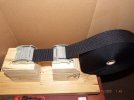Sometimes burrs can be frustrating to completely remove. I am not talking about burrs that can be felt with finger tips, those kind of burrs can be removed with a stone to were they cannot be detected by the skin or nerves in the fingertips, but they can be felt, or detected by taking the edge and dragging the edge backwards/edge leading on the finger nail, you can feel that little micro-white line catch and you can see it very very lightly scraping on the nail. I am talking about to the very very fine white line/fin that can only be seen under a really bright light of a clear overhead light, i can see it most of the time with the naked eye, but sometimes it takes a 10x loupe. Imo, and i maybe wrong but one doesn't need a very expensive high powered microscope to see very very fine, fin/burr. A light will most certainly reveal any flashing or fussy bits. I read online that a human eye can see a candle wicks flame over a mile a way, if that's the case then one can detect a micro-fin/burr under a bright light. Some call this the burr root?? Maybe it is, because when i explained above about catching it on the nail by going backwards/edge trailing against the nail, well to feel it you have to tilt the knife at a way steeper angle that what you sharpened at, that means the burr root if you call it that is at an angle that more obtuse than the original angle you sharpened.
Anyways edge leading vs edge trailing, imo a burr will happen with either, not matter how hard you try, even if you're not aiming for a burr it will happen on a micro-level. In the straight razor hobby/world some think its taboo or cheating if you resort to a compressional substrate with paste or emulsion to remove that wire/fin, meaning some think if you dont finish on the stone and without ending up with that little micro-white line, then you have no skills at sharpening a razor. Sometimes even a abrasive loaded felt can be very difficult to remove that white line. I wanted to post this to hear another's response, not to argue, but i am here to learn, i am the type of fellow who always learns and always open to other people's suggestions and value their experiences.
Anyways edge leading vs edge trailing, imo a burr will happen with either, not matter how hard you try, even if you're not aiming for a burr it will happen on a micro-level. In the straight razor hobby/world some think its taboo or cheating if you resort to a compressional substrate with paste or emulsion to remove that wire/fin, meaning some think if you dont finish on the stone and without ending up with that little micro-white line, then you have no skills at sharpening a razor. Sometimes even a abrasive loaded felt can be very difficult to remove that white line. I wanted to post this to hear another's response, not to argue, but i am here to learn, i am the type of fellow who always learns and always open to other people's suggestions and value their experiences.

